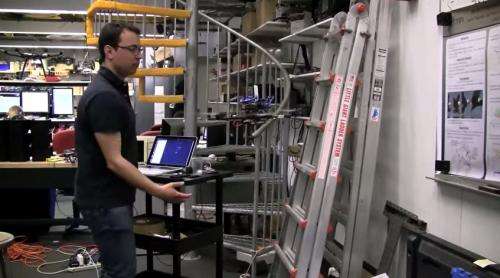May 25, 2014 weblog
Location, location: Tango prototype helps quadrotor navigate (w/ Video)

Project Tango remained in the news this week. There was The Wall Street Journal report that Google may offer a tablet version of its Project Tango's advanced-vision smartphone prototype. There was also news earlier this week about the Project Tango phone prototype used as an enabling tool for autonomous quadrotors, thanks to the right questions and answers worked out by the GRASP Lab at the University of Pennsylvania.
Namely, a lab team at GRASP is using Project Tango's phone to enable the quadrotor to navigate and to stay on its path. (GRASP stands for General Robotics, Automation, Sensing and Perception Laboratory, where they build autonomous robots.) Early this year, Google unveiled the Project Tango smartphone featuring advances in computer vision, with depth-sensor, motion-tracking camera, and vision-processor features. If the device can map 3D presentations, could it be useful for robots that need to move about and locate themselves? A GRASP research group under Professor Vijay Kumar explored the potential; his group works on creating autonomous ground and aerial robots and swarms. They outfitted a quadrotor with the device; they made a video to show its progress. Ars Technica explained what happens: "The computer vision sensors on Tango collect enough data for autonomous navigation to be possible and the on-board processors can handle all the trajectory planning."
According to a report in IEEE Spectrum, Kumar said that the Google device is remarkable because it lets you "literally velcro it to a robot and have it be autonomous." In their trying out the device, it was able to recover and stay on path. IEEE Spectrum's notes on the testing: The group designed and built the quadrotor with off-the-shelf components. Kumar said the only measurement from the Tango phone is its pose, the position plus orientation with reference to a starting coordinate system captured at a rate of 30 Hz. Also, the laptop is not for the purpose of controlling flight but to send a desired trajectory to the drone and to render a visualization of positions in space.
If the Google tablet story was significant in its potential for bringing advanced imaging capabilities to tablets, the GRASP story is of interest to those working with flying robots. The team has shown that indoor navigation is possible without reliance on external sensors. Also, according to IEEE Spectrum, Kumar said Tango was a key advance; it's "lowering the barrier to entry for autonomous robots."
© 2014 Tech Xplore


















